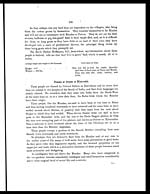Medicine - Institutions > Army health reports and medical documents > Scientific memoirs by officers of the Medical and Sanitary Departments of the Government of India > Number 37 - Investigations on Bengal jail dietaries > Part II > Relationship of food to physical development
(236) Page 226
Download files
Individual page:
Thumbnail gallery: Grid view | List view

226
Their diet in their native conditions is practically anything that they can
catch including jackals, snakes, lizards and insects. At their feasts they consume
large quantities of buffalo meat. They always eat meat when they can get it and
are specially fond of pork. They are clean in their persons and fond of personal
adornment with beads, coins and necklaces made of grass and seeds and other things.
The females are all tattooed in childhood with three—usually vertical—marks on
the forehead a little above the root of the nose. Although their cows are used
in ploughing, milk is made more use of as an article of food by them than by
the Mundas.
It is rare for any aboriginal people to cook food more than once a day. The
rice is cooked in the evening in sufficiently large quantity to provide for two meals,—
one portion is eaten with hot vegetables, meat and condiments at night, and the
remainder is kept and eaten cold, frequently only with salt, at any time from
about 8 A.M. to noon.
| Average height and weight of 100 Uraon prisoners. | Daily food, etc. | ||||||
| Height | —5.3¾" | Rice and dal at both meals. Take marooa bread as morning meal, in the season of the year (August and September). Quantity same as Pater, Munda and Sawansi. Animal food same as Munda or in larger quantities. |
|||||
| Weight | —107½ lbs. | ||||||
This concludes the work that we have been able to perform on Bengal jail
dietaries and on the different problems that have cropped up during the course
of our enquiry. One of the most interesting questions is undoubtedly the
relationship of the degree of nitrogenous metabolism to physical development
and the general characteristics of the people of a race. We have brought a good
deal of evidence forward to show that an intimate connection does exist, and that
diet is a powerful factor in determining the position of a tribe or race in the scale
of mankind.
This line of research we hope further to elaborate from a study of the great
fighting races of the Punjab and Rajputana; at present we know enough to say that
a diet of rice and dal does not appear to conduce to the formation of the special
characteristics that are desirable in those recruited for the fighting line, nor to
the muscular development essential for the performance of a hard day's work.
On the other hand, in those races where an assimilable protein, and particularly
an animal protein forms part of the ordinary diet, muscular development and
good fighting qualities seem to be intimately related with the level of nitrogenous
metabolism attained.
Set display mode to: Large image | Zoom image | Transcription
Images and transcriptions on this page, including medium image downloads, may be used under the Creative Commons Attribution 4.0 International Licence unless otherwise stated. ![]()
| Permanent URL | https://digital.nls.uk/75033423 |
|---|




